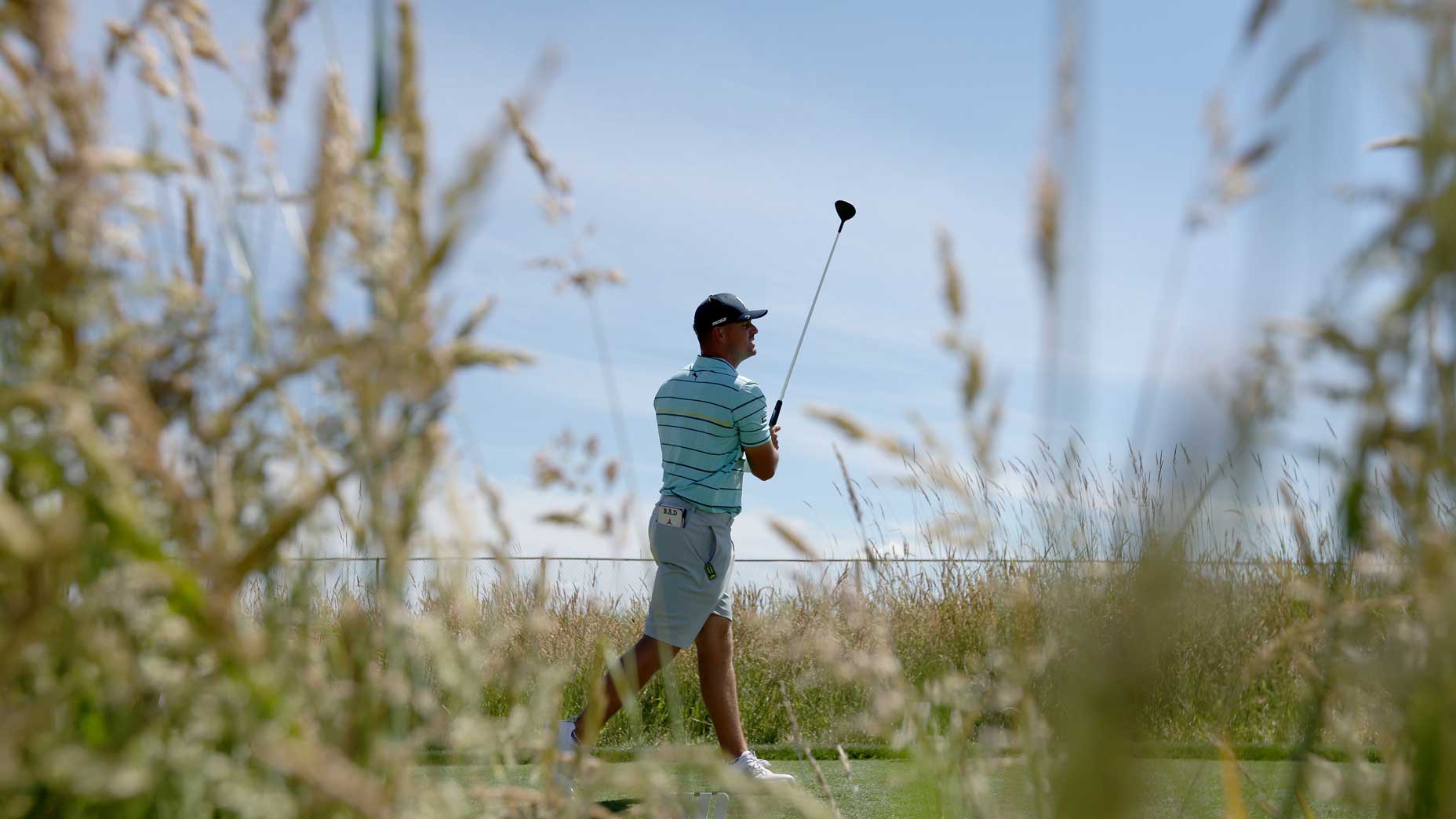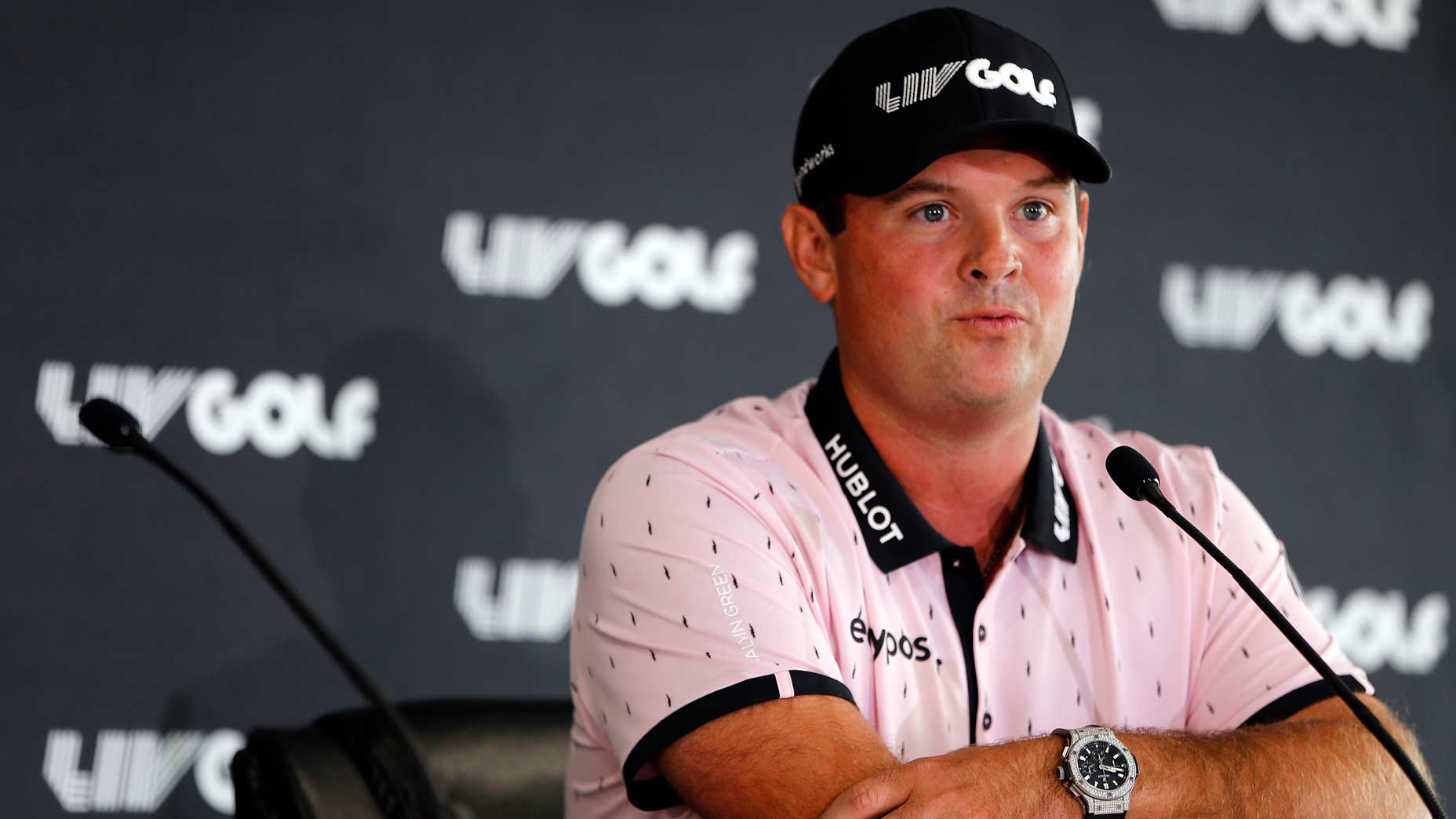
LIV is making its North American debut this week at Pumpkin Ridge in Oregon.
Getty Images
NORTH PLAINS, Ore. — If you start in downtown Portland, Ore., get on Rt. 26, drive west for 20 miles, take exit 55 and cut left through a swath of farmland, you’ll find Pumpkin Ridge Golf Club.
It’s a strange place for a golf revolution. On Wednesday afternoon, a group of men baled hay on the adjacent property. Across the street, they picked strawberries. Inside the gates there were last-minute preparations underway — fences being painted, structures erected, speakers set up and tested. In the world of professional golf, this is currently what revolution looks like. That’s because the group of pros in Wednesday’s pro-am — and, more to the point, Thursday’s shotgun-start tournament — are playing in under the banner of LIV Golf, the Saudi-backed breakaway tour, in open defiance of the PGA Tour. When the event was announced less than three months ago, it would have been hard to believe the star power on the list now teeing it up, a group that includes Phil Mickelson, Brooks Koepka, Dustin Johnson and Bryson DeChambeau. But here they are. The revolution is underway.
Mickelson snagged an open spot on the Pumpkin Ridge range on Wednesday afternoon. He caught the attention of Matthew Wolff, the 23-year-old making his LIV debut this week.
“Pretty enjoyable pro-am experience, huh Matt?” Mickelson called out. He was referring to the lack of fans, to the reasonable pace of play, to the incremental lifestyle improvements of the LIV Tour.
The field of 48 is split into 12 teams, four players and one captain on each; Mickelson is Wolff’s captain on the Hy Flyers. Players compete for an individual prize pool of $20 million but teams compete for a separate pool of money, too. It’s a brand-new format. It has believers and skeptics. But if the scene at Pumpkin Ridge proves anything, it’s this: LIV is here to stay.
To hear them tell it, the players are thrilled to be here. Whatever you may think of LIV, that’s crucial to understanding its future; the pros will be its most effective advocates and recruiters going forward, and happy pros will attract others. One the one hand, it seems obvious that these guys are enjoying the party. Most have just secured enormous sums of money just for showing up, and life is good for those enjoying a sudden influx of generational wealth. On the other hand, given the controversial nature of the tour and the contentiousness at the upper echelons of men’s professional golf, it wouldn’t have been shocking to hear pros express buyers’ remorse, wondering what they’d gotten themselves into.
But this core group has gotten tight, and fast. That began at the inaugural event in London, when some pros spent Saturday’s afterparty recruiting fellow pros via drunken Facetime. It continued with early arrivals this past weekend, when pros made time for some off-course bonding. Pat Perez said he’d accomplished a career first on Sunday, grabbing a beer with Brooks Koepka.
“It’s been incredible, way different from the PGA Tour vibe where everybody is on their own,” Perez said.
Wolff says he holds nothing against the Tour nor its membership, but he echoed Perez’s sentiment nonetheless. In high school and college he’d relished playing on a team, even in an individual sport like golf. When he turned pro, that vanished completely. He couldn’t escape a sense of loneliness.
“Nothing you do in college prepares you for that,” he said on Wednesday. “I didn’t f— with being alone.”
But LIV, he insisted, feels immediately different. There’s the team format, which he immediately embraced. But there are other things tying these men together, too.
“We’ve been banded together by all the scrutiny, by what other people think, and that creates some of this camaraderie,” said Talor Gooch. “And we also believe in this. We believe in the concept, the vision, the people, the future.”
The limited field means there are fewer of them. Their contracts mean most of them have recently come into a large sum of money. The us-against-the-world mentality means they have each other’s backs. Whatever the combination of factors, every pro in the field attended Tuesday night’s tournament party, where teams were announced one by one. They were required to stay until 8 p.m., but nobody left until after 10. Some hung out until the wee hours and showed up to the course groggy on Wednesday. They’re bought into the group dynamic.
That doesn’t mean it was an easy decision to be here in the first place. Abraham Ancer, one of this week’s debutants, made a list of pros and cons. He agonized over the decision, knowing how much the PGA Tour meant and recognizing the thorny geopolitics of going to work for a foreign government with a human rights record like Saudi Arabia. But after he consulted with those close to him, it didn’t take long to sign on.
“I mean, [the contract] came up really quickly,” Ancer said. “The way it happened, it was not something that we’ve been talking about for a while. It just came up really quickly, to be honest.”
He was hardly the only one to make a snap decision.
“You guys will never believe me, but we didn’t have the conversation till everything was done at the U.S. Open and figured it out,” Koepka said. He was announced as a LIV signee just two days later.
It’s remarkable how quickly and seamlessly the who’s-who of tournament golf infrastructure have adapted to a new tournament run by a new organization. That means specific individuals like Slugger White, the ex-Tour rules official, who works for LIV now. It means big-name coaches like Claude Harmon III, Boyd Summerhays and Chris Como, who accompanied their players throughout practice rounds. It means agents, too, helping their clients navigate a new world filled with brand-new questions. Some player-agent pairings have strained or split over the Saudi question. Most haven’t. There was Dave Winkel, Dustin Johnson’s agent, rocking an “Aces” hat on Wednesday, repping his player’s team colors. The times, they are a-changing.
Another reason players are so happy is because their teams are happy. LIV pays for travel and lodging for players as well as caddies, who are typically cash-strapped bargain-hunters during tournament weeks.
“This is easily the nicest place I’ve stayed all year,” one caddie said. “And the cheapest.”
It’s tough to beat free.
DeChambeau delighted at the possibility of bringing his production company inside the ropes alongside him. “Anything we ask for, they’re allowing us to do,” he said. Agents, managers and coaches are welcomed inside the ropes. They were invited to Tuesday night’s party. One coach remarked that LIV is more welcoming than any tour he’s ever been on.
“You have actual human rights out here,” he said, unironically.
Off property, reaction to the tournament is more complex. On Thursday morning, just down the road, a group of 9/11 survivors and family members will hold a protest and press conference objecting to LIV’s Saudi funding. A TV ad is expected to run in Portland all week that includes headshots of tournament participants and encourages viewers to call Pumpkin Ridge and express their dismay. Eleven local mayors have objected to the tournament being held. Senator Ron Wyden has used the tournament to bring up Fallon Smart, a 15-year-old who was run down in Portland in 2016 by a car believed to be driven by Saudi national Abdulrahman Sameer Noorah. Before Noorah ever stood trial, he was believed to have cut off his tracking monitor, picked up in a black SUV and taken back to Saudi Arabia.
None of this is cut-and-dry, of course. Tournament participants have seized on LIV CEO Greg Norman’s talking point about 23 PGA Tour sponsors doing significant business with the Saudis. European Tour CEO Keith Pelley said earlier in the week that he would have considered a deal with Golf Saudi had they not formed a rival tour.
On site at Pumpkin Ridge, players and coaches obsess over what they see as little hypocrisies, like Rory McIlroy speaking out against LIV when he wears Chinese-made Nike shirts, or Brandel Chamblee criticizing LIV defectors when he uses gas in his car. Business is messy, their logic follows. The only consistent thing is not to worry about any of it. In other words, within the LIV bubble, the Saudi conflict is a largely distant worry brushed aside increasingly quickly. On Tuesday, Perez and Koepka were asked if they were concerned about such close association with a brutal regime.
“No,” Perez said. “I don’t have any concerns.”
Koepka backed him up.
“We’re playing golf,” he said dismissively.
On the ground, that’s still mostly what it felt like: Golf. The fan-free practice rounds were particularly low-key, with friends and teams roaming freely across the grounds. The pro-am was a slightly different format than usual, with two pros and two amateurs in each foursome (the PGA Tour typically has one pro with four ams). The music cascading over the driving range was an engaging touch, as were the speakers set up every few holes. And there were tense moments in press conferences — fueled by another good innovation, bringing three players up instead of just one at a time. But the entire setup still followed the general outline of a tournament week. It’s still golf.
So now what? Where and when will professional golf reach equilibrium, and what will that look like?
It’s tough to say. LIV says it has more players under contract to make the leap directly after the Open Championship and is in talks with several more. By year’s end it will have all 48 players under contract for next year, when the tour’s 14-event schedule begins in earnest.
For now, the PGA Tour still claims the top 16 players in the current world ranking. That’s its greatest strength — even the star power in the LIV field is battling injury or past its collective prime. There are other institutional advantages, too: The PGA Tour has TV deals with ESPN, CBS and NBC, effectively boxing out LIV from likely landing spots. And it has decades of tradition and established tournament golf on its side, too. The revolution may be streamed rather than fully televised. The fact that both tours now hold significant power has many players hoping for a compromise.
“I want to continue playing the PGA Tour, and I don’t see why they can’t coexist,” Gooch said. He added that he had never intended to leave altogether; he signed up for the London event as a one-off.
“It worked out best for my schedule to do that and obviously I had the chance to make a bunch of money, so it was a no-brainer,” he said. “I didn’t think they were going to truly suspend us.”
But the Tour did suspend Gooch and the rest of the field indefinitely, with no clear path back to participation. Gooch hopes that changes. Others, like Patrick Reed, sound apathetic about a future on Tour. On Tuesday, Reed announced he’d resigned his Tour membership and didn’t mince words about leadership, either, suggesting they’d failed to “listen to the players” and ultimately brought this on themselves.
LIV representatives insist they continue to be open to sitting down with Jay Monahan, though Norman also spent Wednesday afternoon trolling Monahan on Twitter.
The misconception about LIV itself is that it will never need to make money and exists merely as a vehicle for sportswashing. But the Saudis’ Public Investment Fund doesn’t stay well-stocked by throwing hundreds of millions at a failing sports league. LIV reps insist the venture will eventually need to become profitable, but in the same breath insist they’re looking to 10x the initial investment. One way they’re planning to do so is by introducing franchises and franchise owners, who would pay for the privilege of owning a team.
In other words, LIV’s funding isn’t bottomless nor infinite. Still, it has built an ecosystem in which its players are happy about their treatment and excited for the future. That means the breakaway league is continuing to chip away at its initial objective: player acquisition. It’s not yet clear what that means for golf fans, who are already feeling the effects of a fractured landscape. But it means one thing for sure: golf’s revolution is still just beginning.









